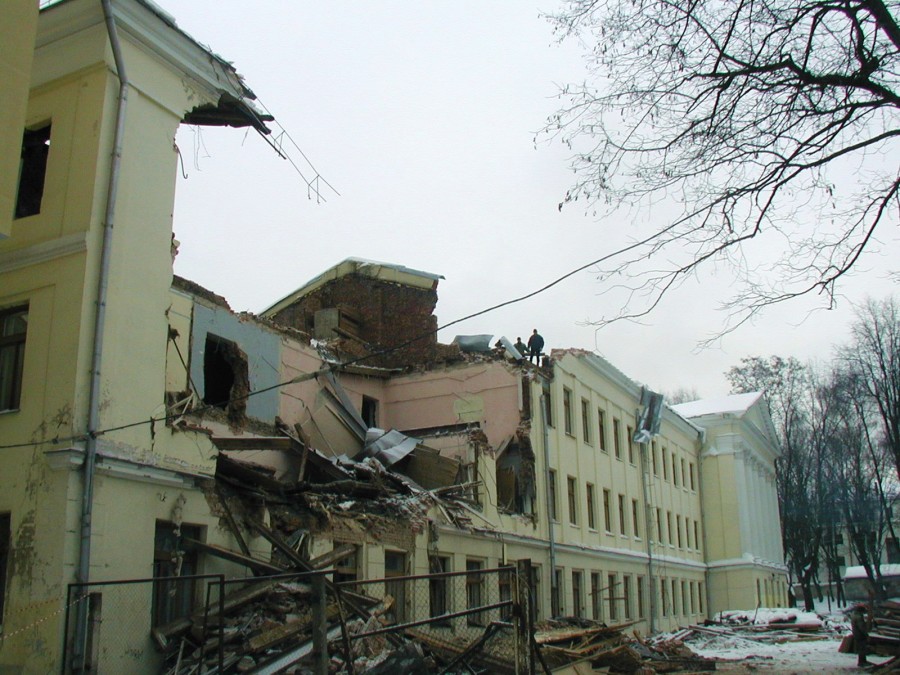Selected dates:
1971
Born in Grodno (BSSR, today the Republic of Belarus).
Until 1989, he studied at the Glebovsky School.
From 1992 to 1997 he studied at the Academy of Arts in Poznan (Poland).
From 1998 to 2000 he studied at The Rijksakademie van Beeldende Kunsten in Amsterdam (Holland).
Alexander Komarov is an artist working with video, text, installation and photography, exploring the themes of language and time in different contexts.
The artist scrupulously studies topics that interest him, whether it be the buildings of the Palaces of the Republic in Minsk and Berlin, his passport (35g, 2005) or the activities of a coal mining company. His video works keep a slow tempo-rhythm, attentive to details and the subject of research. The theme of language, voices and dialogue is explored in many of his video works, for example, in interviews with taxi drivers while traveling around Budapest or in dialogues about invented and endangered words in the Belarusian language in the space of a greenhouse with endangered plant species (Poalipaduazenije, 2013).
Alexander Komarov works in various media: photography, collage, video, installation, performance and others. All his works are characterized by restrained and thoughtful narration, research approach and perfectionism in execution.
The manipulation of reality, perception, the manifestation of power and its historical modification are discussed in all the artist's projects on architecture.
In the series Immersion of Reality / No title (2002–2004), the artist studies the Palace of the Republic in Minsk. By that time, Komarov lived in various Western European countries. Returning to Minsk, he, on the one hand, observed how the monumentality of modern Minsk architecture is connected with the repressiveness of the state system, and on the other hand, what conjectures and clichés are filled with Western media reports about Belarus: “I wanted to keep the Palace in memory as an object from the past and became make a model. However, I did not manage to get the plans of the Palace, and therefore I began to draw and invent them anew, entering into the role of an architect. In one photo montage, I “cut out” a block of the Palace in order to get an idea of the volume it fills in the urban space in the immediate vicinity of low-rise historical buildings. Another photo montage shows an imaginary skyscraper palace stretched hypertrophied upwards. Viewers are not at all surprised by this image, many take it for photographic accuracy. There are so many myths and prejudices about Belarus in Europe that photomontage distortions are easily perceived as a reflection of reality.”
The Berlin Palace of the Republic in Komarov's film "See You in Disneyland" (2006) became the counterpart of the Belarusian palace. Here the artist registered and preserved the mood around the already dilapidated symbol of the power of the GDR. The historical events that led to the demolition of the Palace, to some extent, influenced his own biography, made possible his nomadism as an artist. “What history has discarded, I collect,” he comments on his approach. After the exhibition in Switzerland, the model of the Berlin Palace of the Republic, which Komarov showed along with the video, was stolen and, perhaps, is now serving someone as a private Disneyland.
The artist continues to create projects about architecture: in 2007, he created the film “On Translation: Transparency / Architecture Acoustique” (On Translation: Transparency / Architecture Acoustique) about the transparent dome of the Reichstag and its symbolism.














































.jfif-thumb.jpg?alt=media&token=d6606f9c-4960-4847-a5ac-80dd8fa45dc4)































-Koalicja-No_1-thumb.jpg?alt=media&token=7a0a3b73-4557-4f0b-9acd-39e78780a8bb)
-Koalicja-No_2-thumb.jpg?alt=media&token=1535b44a-e5a7-499d-9651-b35f4fddde8e)

-Koalicja-No_3-thumb.jpg?alt=media&token=e3a9d0c5-8e83-4fe6-9183-ff913c817ee0)






























